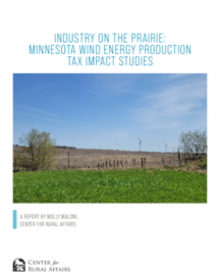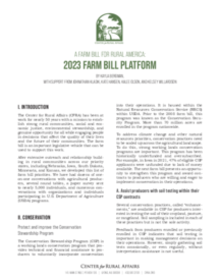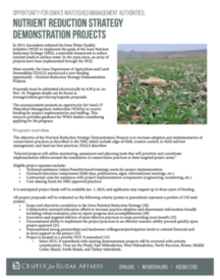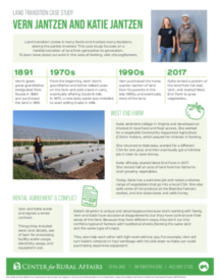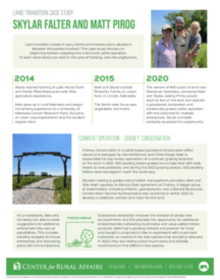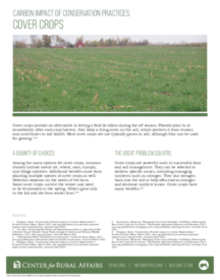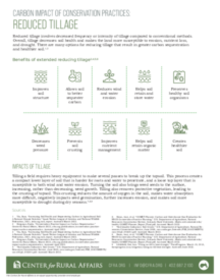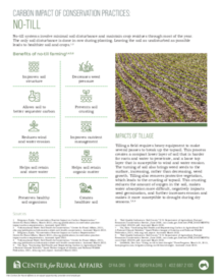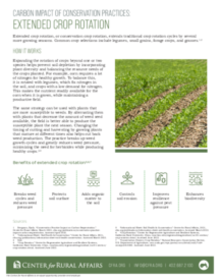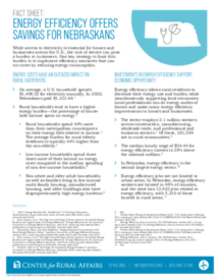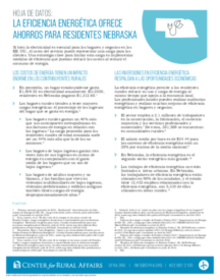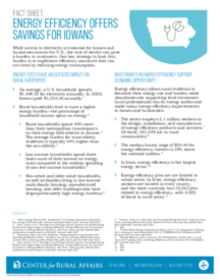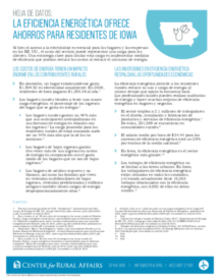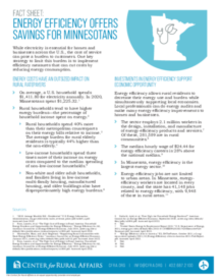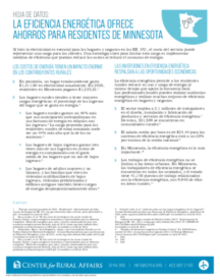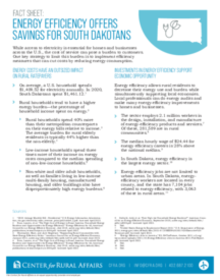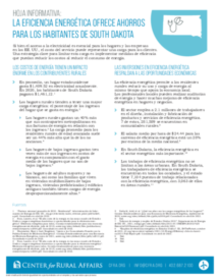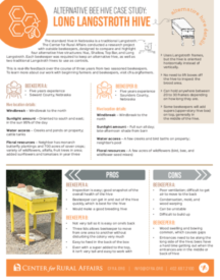We aren't afraid of the weeds. The people living in rural America deserve a serious and in-depth look at the issues and forces impacting their communities.
The Great Plains is an excellent location for renewable energy resources. The wind that steadily blows an open field of prairie grass also moves the blades of wind turbines. As rural populations decline, tax revenue from wind energy production helps offset lower revenues from the shrinking tax base.
- Small Towns
- Policy
The Center for Rural Affairs (CFRA) has been at work for nearly 50 years with a mission to establish strong rural communities, social and economic justice, environmental stewardship, and genuine opportunity for all while engaging people in decisions that affect the quality of their lives and the...
- Lending
- Small Towns
- Farm and Food
In 2013, lawmakers initiated the Iowa Water Quality Initiative (WQI) to implement the goals of the Iowa Nutrient Reduction Strategy (NRS), a statewide framework to reduce nutrient loads in surface water. In the years since, an array of projects have been implemented through the WQI. Most recently...
- Policy
In this edition of the Center for Rural Affairs newsletter, read about how women's voices are creating change in their communities, how a Native Cooperative is cultivating community through corn, and the impact that a bilingual day care is having in a community.
- Lending
- Small Towns
- Farm and Food
- Policy
Land transition comes in many forms and involves many decisions among the parties involved. This case study focuses on a familial transition of land from generation to generation. To learn more about our work in this area of farming, click here.
- Farm and Food
Land transition comes in many forms and involves many decisions between the parties involved. This case study focuses on beginning farmers stepping into a land and cattle operation. To learn more about our work in this area of farming, click here .
- Farm and Food
Cover crops provide an alternative to letting a field lie fallow during the off season. Planted prior to or immediately after cash crop harvest, they keep a living cover on the soil, which protects it from erosion and contributes to soil health. Most cover crops are not typically grown to sell...
- Policy
- Farm and Food
Reduced tillage involves decreased frequency or intensity of tillage compared to conventional methods. Overall, tillage decreases soil health and makes the land more susceptible to erosion, nutrient loss, and drought. There are many options for reducing tillage that result in greater carbon...
- Policy
- Farm and Food
No-till systems involve minimal soil disturbance and maintain crop residues through most of the year. The only soil disturbance is done in-row during planting. Leaving the soil as undisturbed as possible leads to healthier soil and crops. Tilling a field requires heavy equipment to make several...
- Policy
- Farm and Food
Extended crop rotation, or conservation crop rotation, extends traditional crop rotation cycles by several more growing seasons. Common crop selections include legumes, small grains, forage crops, and grasses. Expanding the rotation of crops beyond one or two species helps prevent soil depletion by...
- Policy
- Farm and Food
Read this edition of the Small Business News to celebrate Women's Business Month, hear about Ricardo Pascual's love of cars and his auto sales business, and what you need to know about the Nebraska Advantage Microenterprise Tax Credit.
- Lending
While access to electricity is essential for homes and businesses across the U.S., the cost of service can pose a burden to customers. One key strategy to limit this burden is to implement efficiency measures that can cut costs by reducing energy consumption. On average, a U.S. household spends $1...
- Policy
Si bien la electricidad es esencial para los hogares y negocios en los EE. UU., el costo del servicio puede representar una carga para los clientes. Una estrategia clave para limitar esta carga es implementar medidas de eficiencia que puedan reducir los costos al reducir el consumo de energía. En...
- Policy
While access to electricity is essential for homes and businesses across the U.S., the cost of service can pose a burden to customers. One key strategy to limit this burden is to implement efficiency measures that can cut costs by reducing energy consumption. On average, a U.S. household spends $1...
- Policy
Si bien el acceso a la electricidad es esencial para los hogares y las empresas en los EE. UU., el costo del servicio puede representar una carga para los clientes. Una estrategia clave para limitar esta carga es implementar medidas de eficiencia que puedan reducir los costos al reducir el consumo...
- Policy
While electricity is essential for homes and businesses across the U.S., the cost of service can pose a burden to customers. One key strategy to limit this burden is to implement efficiency measures that can cut costs by reducing energy consumption. On average, a U.S. household spends $1,411.80 for...
- Policy
Si bien la electricidad es esencial para los hogares y negocios en los EE. UU., el costo del servicio puede representar una carga para los clientes. Una estrategia clave para limitar esta carga es implementar medidas de eficiencia que puedan reducir los costos al reducir el consumo de energía. En...
- Policy
While access to electricity is essential for homes and businesses across the U.S., the cost of service can pose a burden to customers. One key strategy to limit this burden is to implement efficiency measures that can cut costs by reducing energy consumption. On average, a U.S. household spends $1...
- Policy
Si bien el acceso a la electricidad es esencial para los hogares y las empresas en los EE. UU., el costo del servicio puede representar una carga para los clientes. Una estrategia clave para limitar esta carga es implementar medidas de eficiencia que puedan reducir los costos al reducir el consumo...
- Policy
The Center for Rural Affairs conducted a research project with outside beekeepers, designed to compare and highlight four alternative hive structures: Nuc, Shallow, Top Bar, and Long Langstroth.
- Farm and Food


